
Plovers are members of a widely distributed group of wading birds of family Charadriidae. The term "plover" applies to all the members of the family, though only about half of them include it in their name.

A snipe is any of about 26 wading bird species in three genera in the family Scolopacidae. They are characterized by a very long, slender bill, eyes placed high on the head, and cryptic/camouflaging plumage. The Gallinago snipes have a nearly worldwide distribution, the Lymnocryptes snipe is restricted to Asia and Europe and the Coenocorypha snipes are found only in the outlying islands of New Zealand. The four species of painted snipe are not closely related to the typical snipes, and are placed in their own family, the Rostratulidae.

Scolopacidae is a large family of shorebirds, or waders, which mainly includes many species known as sandpipers, but also others such as woodcocks, curlews and snipes. The majority of these species eat small invertebrates picked out of the mud or soil. Different lengths of bills enable different species to feed in the same habitat, particularly on the coast, without direct competition for food.

The Rostratulidae, commonly known as the painted-snipes, are a family of wading birds that consists of two genera: Rostratula and Nycticryphes.

The common snipe is a small, stocky wader native to the Old World.
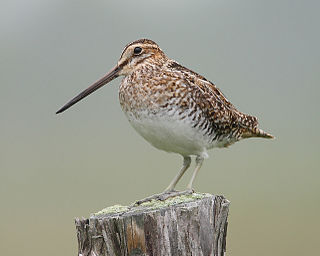
Wilson's snipe is a small, stocky shorebird. The generic name Gallinago is Neo-Latin for a woodcock or snipe from Latin gallina, "hen" and the suffix -ago, "resembling". The specific name delicata is Latin for "dainty".
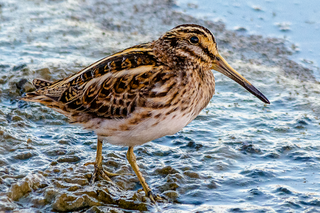
The jack snipe or jacksnipe is a small stocky wader. It is the smallest snipe, and the only member of the genus Lymnocryptes. Features such as its sternum make it quite distinct from other snipes or woodcocks.
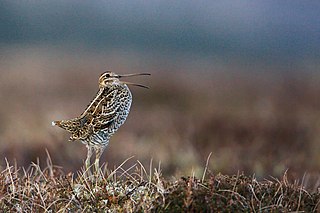
The great snipe is a small stocky wader in the genus Gallinago. This bird's breeding habitat is marshes and wet meadows with short vegetation in north-eastern Europe, including north-western Russia. Great snipes are migratory, wintering in Africa. The European breeding population is in steep decline.

The greater painted-snipe is a species of wader in the small painted-snipe family Rostratulidae. It widely distributed across Africa and southern Asia and is found in a variety of wetland habitats, including swamps and the edges of larger water bodies such as lakes and rivers. This species is sexually dimorphic with the female being larger and more brightly coloured than the male. The female is normally polyandrous with the males incubating the eggs and caring for the young.

Gallinago is a genus of birds in the wader family Scolopacidae, containing 18 species.

The pin-tailed snipe or pintail snipe is a species of bird in the family Scolopacidae, the sandpipers.
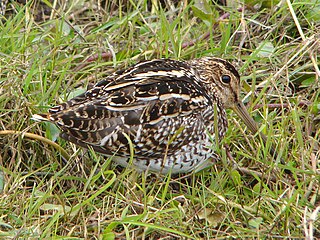
The Pantanal snipe is a bird in tribe Scolopancinai and subfamily Scolopacinae of family Scolopacidae, the sandpipers and relatives. It is found on Trinidad and Tobago, the Falkland Islands, and in every mainland South American country

The puna snipe is a bird in tribe Scolopancinai and subfamily Scolopacinae of family Scolopacidae, the sandpipers and relatives. It is found in Argentina, Bolivia, Chile, and Peru.

Snipe eels are a family, Nemichthyidae, of eels that consists of nine species in three genera. They are pelagic fishes, found in every ocean, mostly at depths of 300–600 m (980–1,970 ft) but sometimes as deep as 4,000 m (13,000 ft). Depending on the species, adults may reach 1–2 m (39–79 in) in length, yet they weigh only 80–400 g (2.8–14.1 oz). They are distinguished by their very slender jaws that separate toward the tips as the upper jaw curves upward. The jaws appear similar to the beak of the bird called the snipe. Snipe eels are oviparous, and the juveniles, called Leptocephali, do not resemble the adults but have oval, leaf-shaped and transparent bodies. Different species of snipe eel have different shapes, sizes and colors. The similarly named bobtail snipe eel is actually in a different family and represented by two species, the black Cyema atrum and the bright red Neocyema erythrosoma.
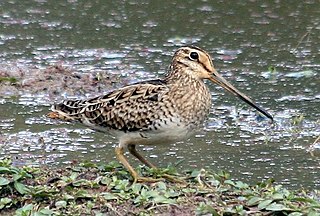
Latham's snipe is a medium-sized, long-billed, migratory snipe of the East Asian–Australasian Flyway.
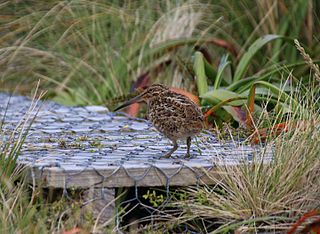
The austral snipes, also known as the New Zealand snipes or tutukiwi, are a genus, Coenocorypha, of tiny birds in the sandpiper family, which are now only found on New Zealand's outlying islands. There are currently three living species and six known extinct species, with the Subantarctic snipe having three subspecies, including the Campbell Island snipe discovered as recently as 1997. The genus was once distributed from Fiji, New Caledonia and Norfolk Island, across New Zealand and southwards into New Zealand's subantarctic islands, but predation by introduced species, especially rats, has drastically reduced their range.
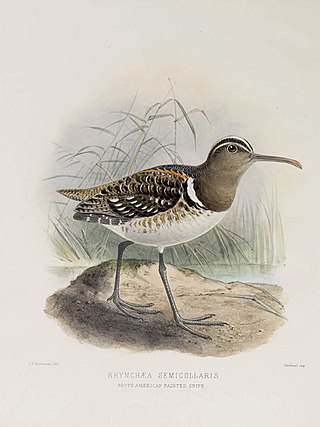
The South American painted-snipe, or lesser painted-snipe, is a shorebird in the family Rostratulidae. There are two other species in its family, the Australian painted-snipe and the greater painted-snipe.

The Chatham Islands snipe, also known as the Chatham snipe, is a species of wader in the family Scolopacidae. It is endemic to the Chatham Islands of New Zealand, and is only found on a few islands in the south of the Chatham Islands group.

The Snares snipe, also known as the Snares Island snipe, or tutukiwi in Māori, is a species of bird in the sandpiper family, Scolopacidae.

The North Island snipe, also known as the little barrier snipe or tutukiwi, is an extinct species of bird in the sandpiper family, Scolopacidae, that was endemic to New Zealand.



















